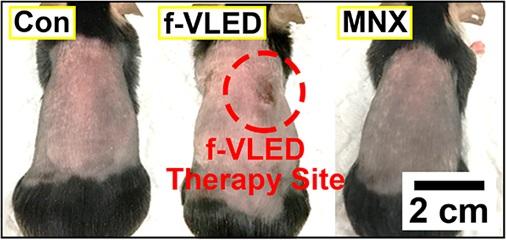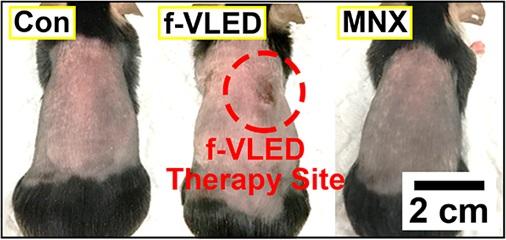
Credit: American Chemical Society
Although some people embrace the saying "bald is beautiful," for others, alopecia, or excessive hair loss, can cause stress and anxiety. Some studies have shown that stimulating the skin with lasers can help regrow hair, but the equipment is often large, consumes lots of energy and is difficult to use in daily life. Now, researchers have developed a flexible, wearable photostimulator that speeds up hair growth in mice. They report their results in ACS Nano.
Affecting millions of men and women worldwide, alopecia has several known causes, including heredity, stress, aging and elevated male hormones. Common treatments include medications, such as minoxidil, corticosteroid injections and hair transplant surgery. In addition, irradiating the bald area with a red laser can stimulate hair follicles, causing cells to proliferate. However, this treatment is often impractical for home use. So, Keon Jae Lee and colleagues wanted to develop a flexible, durable photostimulator that could be worn on human skin.
The team fabricated an ultrathin array of flexible vertical micro-light-emitting diodes (μLEDs). The array consisted of 900 red μLEDs on a chip slightly smaller than a postage stamp and only 20 μm thick. The device used almost 1,000 times less power per unit area than a conventional phototherapeutic laser, and it did not heat up enough to cause thermal damage to human skin. The array was sturdy and flexible, enduring up to 10,000 cycles of bending and unbending. The researchers tested the device's ability to regrow hair on mice with shaved backs. Compared with untreated mice or those receiving minoxidil injections, the mice treated with the μLED patch for 15 minutes a day for 20 days showed significantly faster hair growth, a wider regrowth area and longer hairs.
###
The authors acknowledge funding from the Ministry of Science and ICT.
The abstract that accompanies this study is available here.
The American Chemical Society, the world's largest scientific society, is a not-for-profit organization chartered by the U.S. Congress. ACS is a global leader in providing access to chemistry-related information and research through its multiple databases, peer-reviewed journals and scientific conferences. ACS does not conduct research, but publishes and publicizes peer-reviewed scientific studies. Its main offices are in Washington, D.C., and Columbus, Ohio.
To automatically receive news releases from the American Chemical Society, contact [email protected].
Follow us on Twitter | Facebook
Media Contact
Katie Cottingham
[email protected]
301-775-8455
@ACSpressroom
http://www.acs.org





